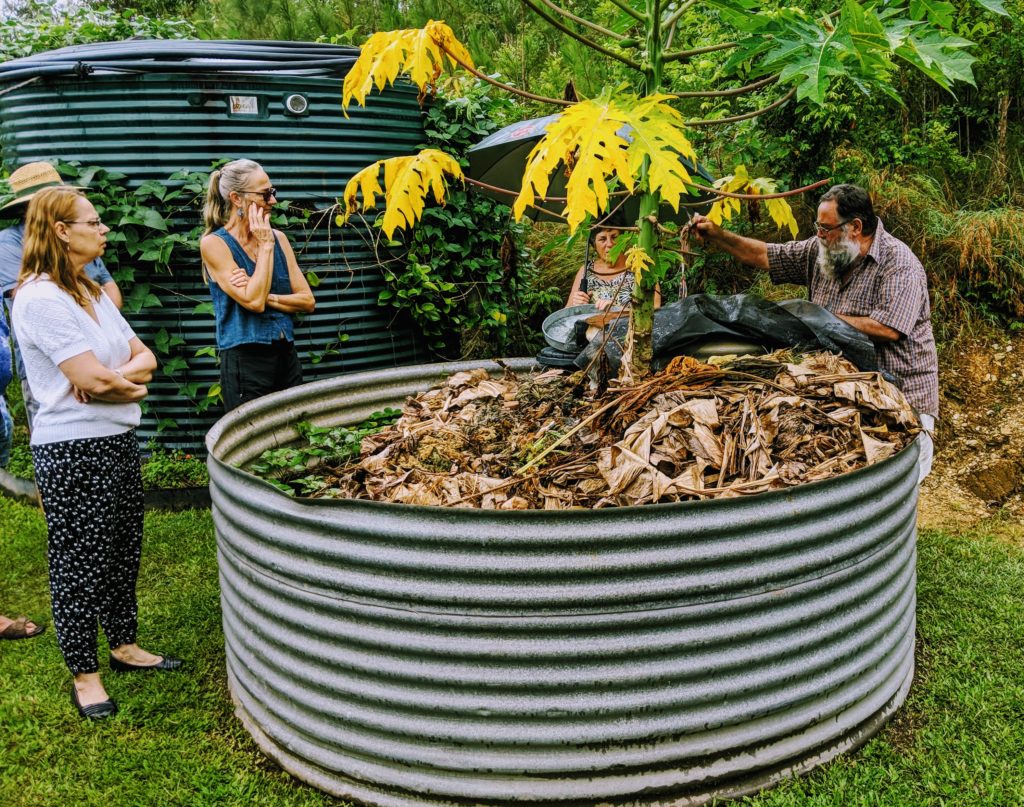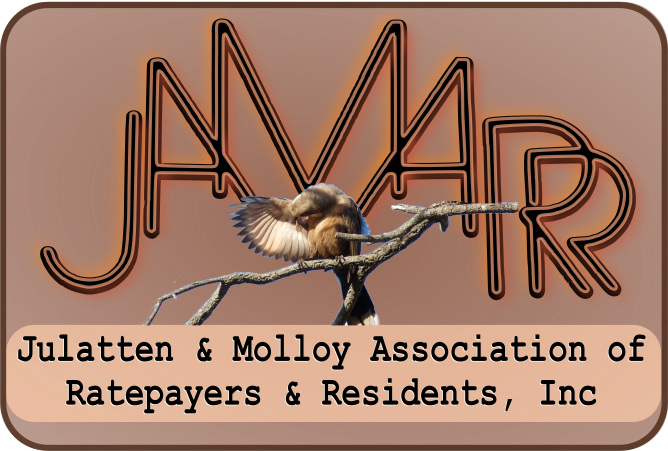04/05/2019
Garlic, microgreens, and a vision of raised beds

The Molloy & Julatten Local Seed Savers Group gathered at Lyn and Reece Gore’s lovely property on 28 April for a convivial session lightly sprinkled with drizzle.
Excellent hosts as always, Lyn and Reece had set out a beautiful spread that soon groaned with contributions from the roll-up. Introductions were made around over steaming cups of of coffee and tea.

Most folks were regular contributors to the group, and it was lovely to have a few new faces as well. There was plenty of information and growing tips exchanged. The central story was how people had coped with the extended Wet this year.
Les reckoned that regular doses of agriphos really helped citrus to make it through the soggy weather. John noted that the pepina cuttings passed along by Duncan and Elizabeth had gone well at the start of the rains but had eventually turned toes up and died. Most people reported losses of one sort or another, but Lyn and Reece said they enjoyed leeks and spring onions all through the season.
That was the queue to have a wander through the garden to see for ourselves.

Beautiful spring onions all rainy season….Can’t argue with that!
A walk in the park
Lyn and Reece are dedicated to raised beds and have made a fine garden system through continuous observation, trial and error, and learning what suits their conditions best.
One of the cluey innovations Reece showed off was a simple method to support climbing vines like snowpeas. A doubled run of monofilament line is strung between stakes and the vines are gently tucked into a twist of the strands…easy-as!
We got a chance to see the new garden shed that Reece has built. It’s a beauty and makes full use of salvaged/re-purposed materials cleverly assembled to make a very impressive home base for their gardening activities.
Big on microgreens
Back up on the veranda we had the privilege of two fantastic presentations. Peter Brown gave us the full benefit of his experience with growing “microgreens” at (modestly) commercial scale.
Microgreens are simply a collection of salad greens harvested while they are quite young. These are in demand at groovy cafes (like the local coffee shop in Mount Molloy) and they make a terrific complement to the table at home too.
Peter uses a large number of shallow trays which he has set up on a custom-built growing table and shade/shelter combo that our resident engineer Brad Bell whipped up. “The roof was important during the rains to keep everything from getting hammered,” Peter noted.

The trays are filled with a good quality loam which Peter builds from green waste, cow dung, sand, creek loam, and hay. Once leveled he uses a straight edge to press in some channels where the seeds will be dropped. For big operations there are more sophisticated solutions like air injection through a grid, but for these trays it’s easy enough to manage by hand.
Peter says he gives the young plants a feed of aquasol or nitrogen once during the growing cycle. He harvests at 3 weeks, usually pulling the whole plant or else clippering leaves near the base depending on what makes the best sense.

Peter encouraged folk to look up microgreen cultivation on YouTube as there are lots of helpful videos. We all reckoned he’s far better than a YouTube and appreciated the chance to get a demo first hand from the farmer himself!
The Garlic Masters
The second presentation of the day was from John Everall. Together with his darling Shirl he has become a legendary garlic grower in the Julatten district. Due to the weather and soil conditions, garlic is not an easy win. John and Shirl have been on this journey for over a decade, and John reckons they finally started getting the hang of it about 7-8 years ago.

After many failed attempts John said they finally got the guidance they needed by turning to the Seed Savers Handbook (by Jude & Michel Fanton).
He explained: “I looked for answers in a lot of places, but didn’t think about the Seed Savers Handbook. Garlic is a bulb, not a seed…but actually there’s so much good information in the Handbook! According to the book, it turns out our issue was with the difference between “day-length critical” and “day-length neutral” types of garlic. In the temperate regions they cultivate day-length critical varieties due to the big swings in day length. In the tropics we don’t have that. Once we focussed on the neutral varieties we were off and running.”
Lyn and John have put together a lovely guide for following the extensive process to get a reliable garlic harvest in the Julatten and Molloy district. You can download it and share around. Give a big thanks to John and Shirl every time to contemplate a magnificent garlic bulb from your garden!











